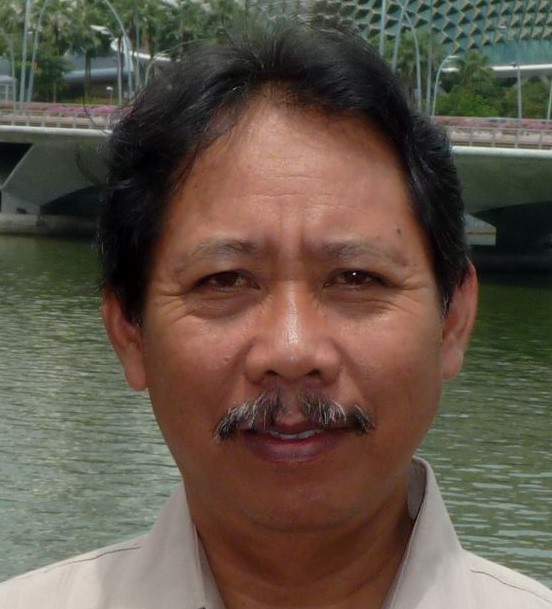Krisdianto
@ulm.ac.id
Mathematics and Natural Sciences Faculty
Lambung Mangkurat University
Currently, an associate professor at Biological Study Program, at Mathematics and Natural Sciences Faculty (MIPA), Lambung Mangkurat University. Has been worked as a lecturer, researcher, and social empowerment for about 34 years.
EDUCATION
1. Undergraduate: Institut Teknologi Bandung, Indonesia, (Biology, Ecology)
2. Postgraduate: Napier University of Edinburgh, Scotland UK (Biological water resource management)
3. Doctoral: Universitas Brawijaya, Indonesia (Natural resource and environmental management), Indonesia
RESEARCH INTERESTS
Urban and Wetland Ecology, Biodiversity, Environment
Scopus Publications
Scopus Publications
R G H Rahmanto, R Damayanti, D A Agustiningrum, C Oktapiani, E R Satiti, Tutiana, L M Dewi, Krisdianto, Andianto, Djarwanto,et al.
IOP Publishing
Abstract Indonesia is a mega-biodiversity country that grows about 4000 timber producer tree species in tropical rain forest. The comprehensive information of wood properties and quality is important in managing the natural resources sustainably. However, stem in basic properties studies of wood from the natural forest is limited because of some difficulties in harvesting until the transportation process. Hence, study the wood branches becomes a solution, as sometimes wood core samples are not adequate. The question was whether the branch properties could represent the main stem properties? Wood anatomy is an important wood property that can predict the other properties, for instance, the physical and mechanical properties, that determine the effective use of this material. This paper aims to present the comparison of wood anatomical properties of branches and main stem of seven commercial wood species. Quantitative and qualitative anatomical structures were investigated according to the International Association of Wood Anatomist (IAWA) Committee. Result shows that the quantitative wood anatomy of four samples (Mimba, Leda, Jabon, and Bintangur) was statistically different, while only one parameter in Tusam, Mindi, and Khaya was different. Accordingly, it can be concluded that studying the wood properties could be carried out using branch effectively.
Basrudin, Husna, F D Tuheteru, A Arif, Albasri, I Mansur, and Krisdianto
IOP Publishing
Eha is one of the important plants in Indonesia’s tropical forests that has important ecological and economic value. During this time Eha is cultivated generatively through seeds, but because of the often constrained seasons and availability of seeds, therefore, we need an alternative cultivation technology with vegetative propagation. This study aims to examine the influence of seedlings height and planting media on the growth of Eha from the extraction of natural saplings. This study was compiled based on a Complete Randomized Design of factorial patterns consisting of two factors. The first factor is the height of seedlings consisting of 3 levels of treatment, namely height 10 cm, 20 cm and 30 cm). The second factor is the type of media consisting of 3 levels of treatment, namely soil, 1:1 sand soil and 1:1:1:1 husk charcoal sand soil. The results show that a seedling height of 20 cm can increase the percentage of life, the percentage of buds and the number of leaves of Eha from the extract of natural saplings. The composition of the best planting medium is a mixture of soil and sand (1:1) because it tends to give the best results against the percentage of sprouts and the percentage of life Eha from the extraction of natural saplings.
Andianto, L M Dewi, R Damayanti, Krisdianto, and H Oktariani
IOP Publishing
R Damayanti, L M Dewi, B Ozarska, J Illic, G Pari, and Krisdianto
IOP Publishing
Krisdianto, Slamat, Fahmi Anshari, and Ika Oksi Susilawati
IOP Publishing
R Damayanti, E Prakasa, Krisdianto, L M Dewi, R Wardoyo, B Sugiarto, H F Pardede, Y Riyanto, V F Astutiputri, G R Panjaitan,et al.
IOP Publishing
Deden Sumirat Hidayat, Lindung Parningotan Manik, Yulia Aris Kartika, Esa Prakasa, Bambang Sugiarto, Yan Rianto, Ratih Damayanti, Krisdianto, and Listya Mustika Dewi
IEEE
Indonesia is a very rich country in tree species that grows in the forest. The forest area has ± 4,000 wood species, about 1,044 timbers have now been traded. The Xylarium Bogoriense 1915, which is the biggest wood library in the world with 193,858 specimens (October 2018), has been collected from all regions in Indonesia since 1914. The collections currently are being digitalized to manage these diversities in a structured manner. Besides that, the images are also used to improve the automatic wood identification system. This paper evaluates the compression techniques that are used in the digital xylarium system to reduce data storage and to speed up data transmission. Other than the time consumption and the result size of the compression, three quality metrics such as SSIM, MSE, and PSNR are also measured.
Salma, P. H. Gunawan, Esa Prakasa, Bambang Sugiarto, Riyo Wardoyo, Yan Rianto, Ratih Damayanti, Krisdianto, and Listya Mustika Dewi
IEEE
Wood is one of Indonesia’s very rich natural resources abundant because the number reaches around 4,000 species. The process of identifying wood species currently it is still done manually in a relatively long time by observing types of fibers, vessels, rays, and other structures directly because there is not a much automatic application of identification of wood species is made. This is an obstacle for experts anatomy of wood because it must check wood species accurately and quickly. Therefore that, the field of Computer Vision is the right solution to develop the process Identification of wood species automatically. In this research program will be made application of Computer Vision to identify wood species with using the Daubechies Wavelet (DW) and Local Binary Pattern (LBP) methods for The extraction of the wood pattern is then classified Support Vector Machine (SVM) method. Results obtained in this study is able to identify the microscopic image of wood as a species of wood with average SVM accuracy is 85%.

